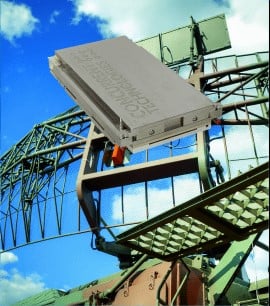Concurrent Technologies plc (LON:CNC) Strategy Director Nigel Forrester caught up with DirectorsTalk to discuss the rationale behind introducing a systems product, what they mean by ‘application enabling systems’ and whether they are limited to making systems with their own content.
Q1: Historically, Concurrent Technologies have made Plug in Cards, what’s the rationale behind introducing a systems product?
A1: So, the simple answer is that we are delivering on our growth strategy which we’ve been working on since Miles Adcock joined as CEO just over a year ago but, let me give you a bit more colour on that.
So, just step back a bit, you said very concisely what we’ve done in the past, which is deliver these Plug in Cards that go into systems. Now, specifically, our major focus has been on Intel processor-based Plug in Cards and the cards that we do, we’ve been very successful with those and we’ve actually just developed a whole new range of Plug in Cards that will take us into the next step in the market. However, the total available market for Plug in Cards is x, and I’m not giving you a number there, but the total available market for system level products is more than that for the Plug in Cards. In fact, the latest available survey, which was taken in 2020, set the total available market for these system level products that are based on the same technology as Helios, our first deployable system that we announced last week, at just over $100 million, but that was growing at an 18% CAGR. Now obviously Helios is an application specific product, it’s not suddenly going to deliver on that total available market, but the serviceable market for Helios is a percentage of the total and it’s definitely positive for the business. Something that we didn’t do previously and we are doing now.
If you step forward a bit by delivering application enabling solutions as well as entering a slightly different space of the market, we are also shortening the time it takes our customers to get their products to market. So, these are quite complex Plug in Cards, there’s quite a lot of detail and because we’ve been working on the technology for many years, we’ve got lots of experience in the underlying standards and how to make them work really well. Many of our customers don’t have that experience, so by delivering something that’s closer to a solution, we are left shifting them, and as 70% of our businesses in the defence space, it often takes quite a long time to go from an initial delivery – so that the customer can start developing – to actually them deploying that product in the marketplace. So, anything we can do to shorten that is a win-win really for both of us.
In overall summary, by selling our Plug in Cards to a slightly different space and a slightly different area, we are basically going to provide an additional option and that also gives us a starting point for future similar systems.
Q2: Is that something that you’re going to do more of going forward then?
A2: That’s absolutely our intention, and there’s several ways that we can deliver on that.
So, within Helios itself, we’ve been quite clever in the design of the product and we have the ability to add some user-specific capability, so to deal with specific input/output circuits, for example, that the customer might have. We’ve got the ability to add some additional removable storage without any change to the product at all so it’s really easy to do, virtually no effort for us. So, we can do a number of different derivatives of effectively the same thing.
The next step for us is to alter the Plug in Cards that we are using as a basis to suit the customer’s application. So, specifically Helios is designed to fulfil vision applications, but within the same physical enclosure, same power capability, we have a number of different Plug in processor cards and other Plug in Cards so that we can create variants that deliver more intensive storage applications or better command and control or signal processing, for example. That means that we’ve got quite a lot of flexibility within the design to do different things by putting in different internal components. So, there’s a little bit more involved in that, but we’re not fundamentally changing the look and the feel of the product, if you like.
Further on, to deliver on the final part of the strategy really is that there’s a lot more we can do in terms of other systems to meet specific customer demands and we’ll obvious be saying more about that as we announce new products.
Q3: Now, you describe these as application enabling systems. What does that mean?
A3: So, an application enabling product is suitable for a customer to load their application so it provides the core hardware and a level of capability without being a finished product. We’re not competing with our products.
We describe Helios, for example, as being suitable for applications like 360 degree situational awareness, and that’s because it’s got some number of video inputs for sensors like cameras, and it’s got some video outputs for display purposes. Our customers, what they do really is that they deliver the end application that turns the capability that we are providing into something that’s specific for that vehicle or helicopter or aircraft frame.
We are not application experts, we are not delivering an end product, we’re not competing with our customers in any way, but what we are delivering is something that allows our customers a degree of flexibility and the ability to concentrate on their end user application.
We’ve seen over the course of perhaps the last 5-10 years, many more of our customers have become much more application-focused themselves, they don’t really want to get to grips with some of the more basic hardware capability, that’s where we excel.
Q4: Is Concurrent Technologies limited to making systems with your own content?
A4: That’s our major intent obviously because we make a great range of Plug in Cards and so our focus with deployable systems or rugged systems is that we’re going to use our own products as the basis of those solutions.
However, we have a number of long term partnerships with companies that specialise in adjacent technologies, and those partnerships allow us to build more valuable solutions. I suppose very basic to some extent because where we specialise in certain types of cards, some of our partners have years of experience in the sort of things that they do. A couple of simple examples, we’ve got a number of partners who specialise in the ability to deal with legacy interfaces so many of the things that we do in the defence space, whilst they’re quite state of the art, they still have to interface to historic interfaces that have been around a long time. We don’t have those in our core product, but we are able to easily add those in products like Helios. There’s also another class of partners that we deal with who are very specialised in making things like accelerator functions that sit alongside our core processor cards, and they provide things that we can’t do around things like sensor processing or sensor data processing. It’s much more effective for us to partner with those type of experts, I suppose, rather than try to deliver that sort of functionality ourselves, providing we built in the capability in our product to do that, which we have.
We’ve offered development systems in the past, but we haven’t offered a deployable solution, and with Helios, we’re actually now meeting that gap and it’s obviously designed to meet the necessary environmental and rugged specifications that our customers need in those type of deployable environments and get them to market quicker and based on state of the art Plug in Cards from Concurrent Technologies.
It’s a good strategy.








































